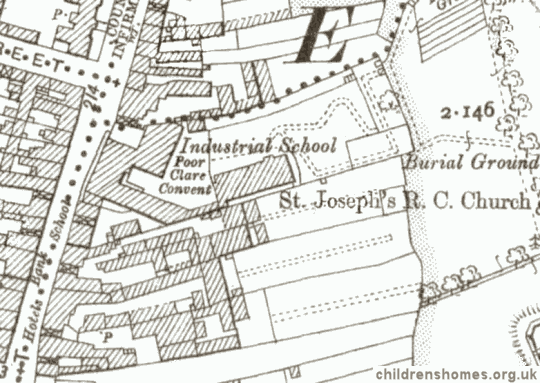St Joseph's Industrial School for Roman Catholic Girls, Cavan, Co. Cavan, Republic of Ireland
St Joseph's Industrial School for Roman Catholic Girls, Cavan, also known as St Joseph's Orphanage, was opened in 1869 by the Sisters of the Poor Clares. It occupied part of the St Joseph's Abbey site on Main Street, Cavan, which also included the Sisters' convent and a National School, which was attended most of the town's poor children. The Industrial School premises were formally certified to begin operation on 1 October 1869, with accommodation for 100 girls. The manager was Sister Catherine Murphy assisted by two other Sisters.
An inspection report in 1872, described the School building as "fine and roomy" but was unhappy with the establishment's location on a street where the local sewerage system was defective and with an open drain not far away which conveyed the filth of the town. The School's cow pasture did not adjoin the premises and the girls had no pace to exercise under the eye of the Sisters. The following year, a new refectory was added to the facilities, and the former refectory converted into an infirmary — children had previously been sent to the workhouse infirmary when unwell. Baths supplied with hot water had also been installed in the school.
The School site is shown on the early 1900s map below.

St Joseph's Industrial School site, Cavan, early 1900s.
Classroom lessons included reading, writing, arithmetic, dictation, grammar, geography, and vocal music according to Hullah's system. Some girls who were being trained as teachers, are taught instrumental music. In their industrial training, the inmates learned lacework, needlework, the use of the sewing machine, laundry-work, and the general duties of household servants. The children were also taught to care for pigs and poultry, milk cows, make butter, bake bread, make pastry, cakes, custards, and puddings. The girls made their own clothes and also made items for shop sale. The girls engaged in household duties during the day received scholastic instruction in the evenings.
An inspection in 1912, noted that the manager was Sister M.E. Donnelly, assisted by six other Sisters of the order. A new classroom had been built, with a cloister beneath it, for the children's use. The girls had drill three times each week for half an hour and did exercises with dumb-bells and bar-bells.
At around 2a.m. on 24 March 1943, fire broke out in the School's laundry, which lay below one of the girls' dormitories. The fire spread rapidly and soon became a smoke-filled inferno. Screaming children in their night clothes rushed from the building, and others jumped forty feet from the upper floors. Many children were taken the County Hospital with injuries sustained while escaping. A total of 35 girls and one elderly woman lost their lives in the blaze, although a further 52 children escaped. Thanks to the efforts of the fire brigade, only the orphanage part of the building suffered serious damage. The nuns were exonerated in the subsequent inquiry.
The School finally closed in 1967. The surviving abbey buildings are now used as retail premises.
Records
Note: many repositories impose a closure period of up to 100 years for records identifying individuals. Before travelling a long distance, always check that the records you want to consult will be available.
- Barnardo's Origins Tracing Service — for people (and their families) who spent all or part of their childhood in an Irish Industrial School and are interested in tracing information about their parents, siblings or other relatives.
- Irish Petty Sessions Court Registers 1828-1912 (available online to subscribers of FindMyPast) include details of committals to Irish Reformatories and Industrial Schools.
Bibliography
- Arnold, Mavis, and Laskey, Heather Children of the Poor Clares (2004, Appletree Press)
- Barnes, Jane Irish Industrial Schools 1868-1908 (1989, Irish Academic Press)
- Dunne, Joe The Stolen Child: A Memoir (2003, Marion Books)
- Rafferty, Mary and O'Sullivan, Eoin Suffer the Little Children: The Inside Story of Ireland's Industrial Schools (1999, New Island Books)
- Touher, Patrick Fear of the Collar: Artane Industrial School — My Extraordinary Childhood (1991, O'Brien Press)
- Tyrrell, Peter and Whelan, Diarmuid Founded on Fear: Letterfrack Industrial School (2006, Irish Academic Press)
- Wall, Tom The Boy from Glin Industrial School (2015, Tom Wall)
- Higginbotham, Peter Children's Homes: A History of Institutional Care for Britain's Young (2017, Pen & Sword)
- Mahood, Linda Policing Gender, Class and Family: Britain, 1850-1940 (1995, Univeristy of Alberta Press)
- Prahms, Wendy Newcastle Ragged and Industrial School (2006, The History Press)
Links
- Glencree Reconciliation Centre (former Reformatory site)
- The Commission to Inquire into Child Abuse
Except where indicated, this page () © Peter Higginbotham. Contents may not be reproduced without permission.


